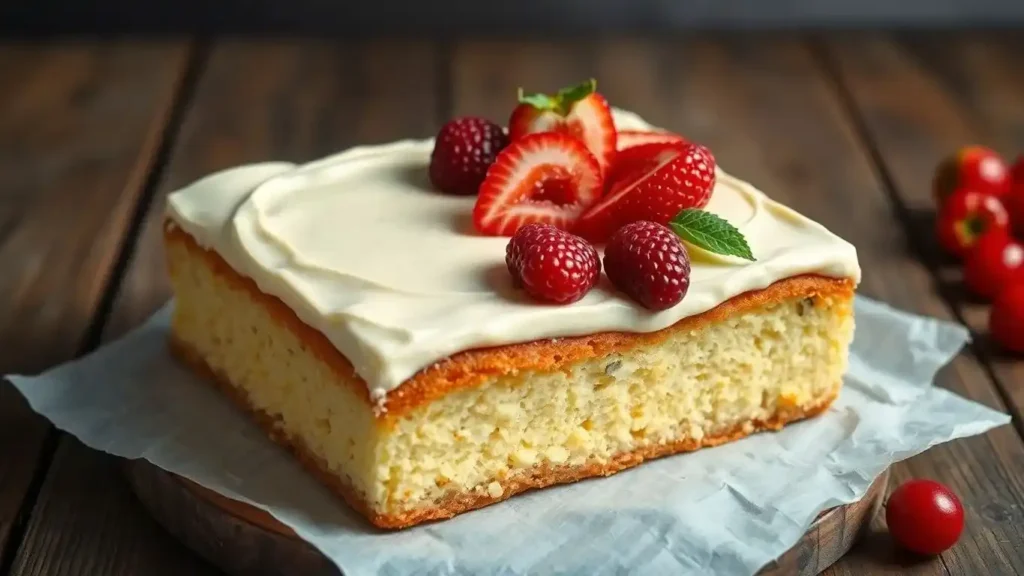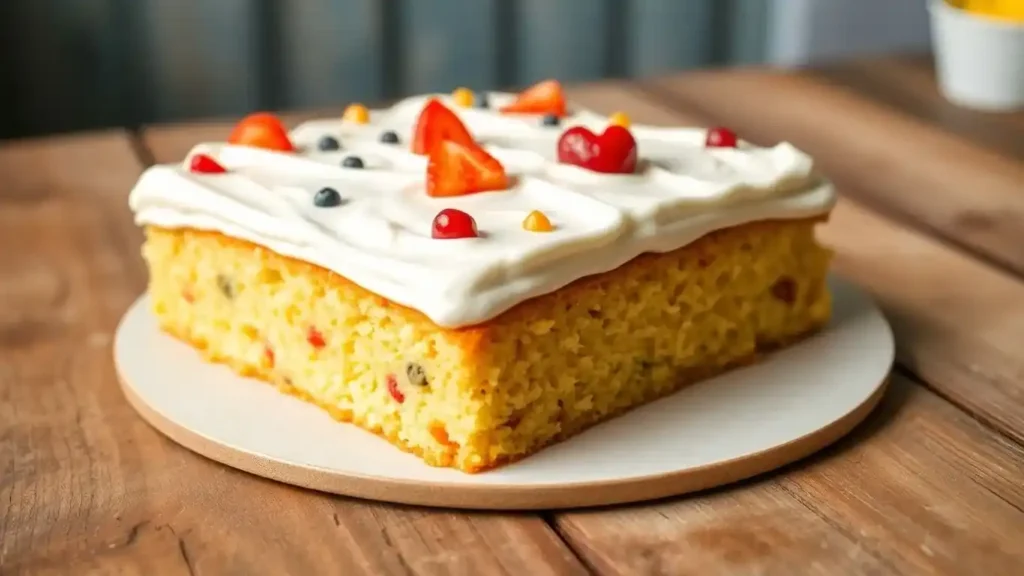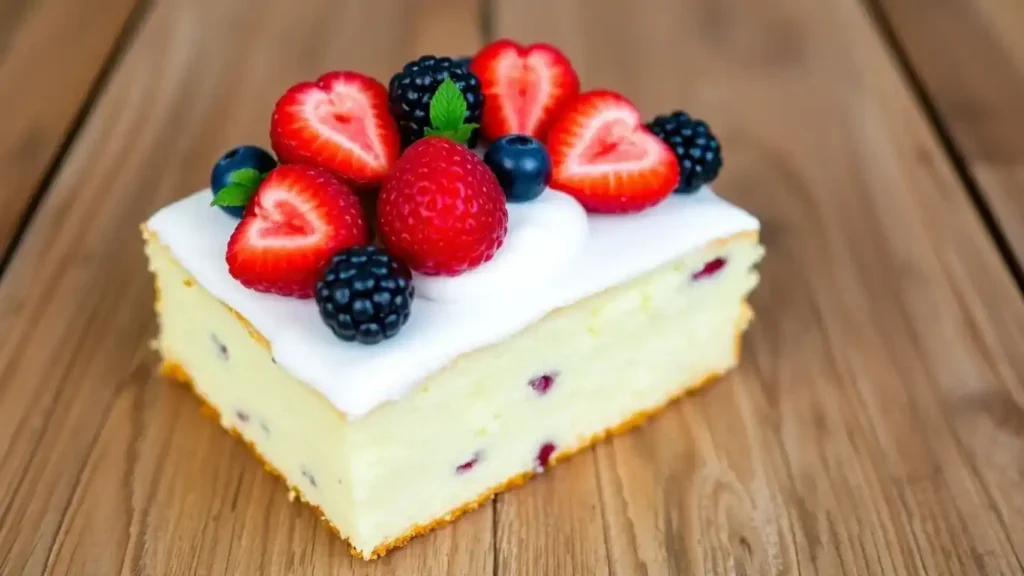Understanding the Basics of Kefir Sheet Cake

What Makes Kefir Unique in Baking
Kefir Sheet Cake let talk about kefir, is a fermented dairy product that’s similar to yogurt but with a thinner consistency. It’s packed with probiotics, which are great for gut health. When it comes to baking, kefir’s acidity works wonders. It reacts with baking soda or baking powder, creating air bubbles that make your cake rise beautifully. This results in a light, fluffy texture that stays moist longer than cakes made with regular milk. Plus, the tangy flavor of kefir adds a nice twist to the sweetness of your cake, making it a bit more sophisticated.
Essential Ingredients for a Perfect Cake
To bake a delicious kefir sheet cake, you’ll need a few key ingredients:
- Kefir: The star of the show, providing moisture and tang.
- All-purpose flour: Gives the cake structure.
- Sugar: For sweetness.
- Eggs: To bind everything together.
- Butter or oil: Adds richness and helps keep the cake moist.
- Vanilla extract: For flavor.
- Baking powder and baking soda: These help the cake rise.
- Salt: Enhances the flavors.
Optional ingredients like fruits or nuts can also be added for extra texture and flavor.
Common Mistakes to Avoid
Baking with kefir is pretty straightforward, but there are some common pitfalls to watch out for:
- Overmixing the batter: This can make your cake dense instead of fluffy.
- Incorrect oven temperature: Too hot or too cold, and your cake might not bake evenly.
- Using the wrong type of kefir: Ensure you’re using plain, unsweetened kefir for the best results.
- Skipping ingredient preparation: Measure everything accurately to keep the balance right.
- Neglecting proper measurement: Especially for dry ingredients like flour, which can affect the cake’s texture.
Baking is a science, but it’s also an art. Pay attention to the details, and your kefir sheet cake will be a masterpiece every time.
Step-by-Step Guide to Baking Kefir Sheet Cake

Preparing Your Ingredients
Starting with a well-prepped kitchen is key for any sheet cake recipe card. Gather all your ingredients before you begin. This includes measuring out your flour, sugar, and kefir, and ensuring your eggs and butter are at room temperature. For a smooth baking process, sift together in a separate bowl all-purpose flour, a teaspoon of baking soda, and salt. This helps in avoiding lumps and ensures an even mix.
Mixing and Baking Techniques
In a large mixing bowl, combine your wet ingredients: kefir, sugar, eggs, and melted butter. Whisk until smooth. Gradually add your dry ingredients into the wet mixture, stirring gently to form a cake batter. Be cautious not to overmix, as this can lead to a dense cake. Pour the batter into a greased baking sheet, spreading it evenly. Preheat your oven to 350°F and bake in the preheated oven for about 25-30 minutes. Keep an eye on it—once a toothpick inserted in the center comes out clean, it’s ready.
Cooling and Serving Suggestions
After baking, let the cake cool in its pan for about 10 minutes. Then, transfer it to a wire rack to cool completely. This step is crucial for maintaining the cake’s moisture. Once cooled, cut into squares or rectangles. You can enjoy it plain or add a simple glaze or frosting. If you’re feeling fancy, a sprinkle of powdered sugar or a dollop of whipped cream with fresh fruits can elevate your cake. Happy baking!
Creative Variations of Kefir Sheet Cake
Fruit-Infused Options
Adding fruits to your kefir sheet cake is a great way to bring in fresh, vibrant flavors. Consider tossing in some blueberries, raspberries, or even diced apples. These fruits add a pop of color and a burst of flavor to every bite. For a citrusy twist, try incorporating some orange zest into your batter. It not only adds a lovely aroma but also gives the cake a refreshing lift. Remember, lightly dust your fruits with flour before mixing them into the batter to prevent them from sinking while baking.
Chocolate and Spiced Twists
For chocolate lovers, incorporating cocoa powder into the mix can transform your cake into a chocolatey delight. Sprinkle some chocolate chips on top before baking for an extra indulgent treat. If you’re in the mood for something cozy, add spices like cinnamon or nutmeg to your batter. These warm spices pair beautifully with the tangy kefir, creating a cake that’s perfect for a chilly evening. You can even use a chocolate cake mix as a base for a quick and easy chocolate twist.
Dairy-Free and Gluten-Free Alternatives
Don’t let dietary restrictions hold you back from enjoying a delicious kefir cake. Substitute regular kefir with almond, coconut, or soy-based kefir to make your cake dairy-free. For a gluten-free option, use a 1:1 gluten-free baking flour blend. Ensure all other ingredients, like baking powder, are certified gluten-free to keep your cake safe for everyone to enjoy.
Whether you’re experimenting with new flavors or sticking to a traditional cake recipe, kefir sheet cake offers endless possibilities for baking inspiration. The moist cake texture and the tangy kick from kefir make every slice a delightful experience.
Enhancing Your Kefir Sheet Cake with Toppings
Simple Glazes and Frostings
Transform your kefir sheet cake into a beautiful cake with just the right topping. A classic cream cheese frosting can add a tangy taste that complements the cake’s natural tenderizer effects from the kefir. Opt for a fluffy cream cheese frosting for a light finish or go with a deeper chocolate flavor for a richer touch. For a simple yet elegant finish, drizzle a lemon glaze over the top. The citrus zest not only adds a burst of flavor but also enhances the cake’s tangy flavor.
Whipped Cream and Fresh Fruits
Whipped cream paired with fresh fruits can elevate your cake to the next level. Spread a layer of unsalted butter whipped cream over the cake and top with berries or slices of citrus fruits for a refreshing contrast. The combination of creamy and fruity flavors will give your cake a depth of flavor that’s hard to resist.
Elegant Powdered Sugar Finish
If you’re aiming for a minimalist yet elegant look, dusting your cake with powdered sugar is the way to go. This simple touch can highlight the cake’s moist texture while adding a subtle sweetness. To keep the powdered sugar fresh, cover your cake with plastic wrap until ready to serve. This method ensures your cake ingredients remain protected, preventing dense cakes from forming.
Toppings can transform a simple cake into a show-stopping dessert. Whether you prefer a tangy glaze or a rich frosting, the right topping can highlight the unique flavors of your kefir sheet cake, making it a memorable treat for any occasion.
For those looking to experiment, consider a special ingredient like lemon zest to add a unique twist to your toppings. The possibilities are endless, so have fun creating your perfect cake masterpiece!
Troubleshooting Common Issues in Kefir Sheet Cake
Dealing with Dry or Dense Cake
Baking a kefir sheet cake can sometimes lead to a dry or dense result, which is not what you want. Here’s how to avoid it:
- Measure Ingredients Accurately: Make sure your dry ingredients like flour and sugar are measured correctly. Use a kitchen scale or measuring cups and level off with a knife.
- Avoid Overmixing: Stirring the batter too much can activate gluten, leading to a dense cake.
- Check Your Baking Time: Typically, the cake should bake for 40-50 minutes. Ensure you’re not overbaking by checking for doneness with a toothpick.
Correcting Flavor Imbalances
Sometimes your cake might taste off, either too tangy or too sweet. To fix this:
- Balance the Dry Mixture: Ensure you’re using the right amount of baking soda or powder, as too much can alter the taste.
- Adjust Sweetness: If the cake is too tangy, consider adding a bit more sugar next time.
- Use Plain Kefir: Avoid flavored kefir as it can introduce unexpected flavors.
Adjusting for Altitude and Humidity
Baking at high altitudes or in humid conditions can be tricky. Here’s what to do:
- Modify Baking Time: At high altitudes, you might need to bake longer. Start checking at the 40-minute mark.
- Adjust Liquid Ingredients: In humid areas, reduce the liquid slightly to prevent a soggy cake.
- Increase Oven Temperature: Sometimes increasing the oven temp by 15-25°F helps with uneven baking caused by altitude.
Remember, baking is as much about patience as it is about precision. Don’t be afraid to make adjustments and learn from each bake.
Health Benefits of Kefir in Baking
Probiotic Advantages
Kefir is packed with probiotics, which are good bacteria that support your gut health. These probiotics can help maintain a balanced gut microbiome, which is crucial for digestion and overall well-being. Including kefir in your baking not only enhances the cake’s flavor but also adds a health boost with every bite.
Nutritional Profile of Kefir
Kefir is not just about probiotics; it also boasts a rich nutritional profile. It contains vitamins such as B12, calcium, and magnesium, essential for bone health and energy production. Plus, it’s a good source of protein, which is vital for muscle repair and growth. When mixed with ingredients like baking powder and baking soda, kefir helps create a light, airy texture in cakes, making them both delicious and nutritious.
How Kefir Supports Digestive Health
The probiotics in kefir are known to support digestive health by helping break down food more efficiently. This can lead to improved nutrient absorption and reduced bloating. By using kefir in baking, you’re not only making your cakes tastier but also easier to digest. This makes kefir sheet cakes a great option for those who might have sensitive stomachs or digestive concerns.
Baking with kefir isn’t just about taste; it’s about creating a dessert that nourishes your body. The combination of probiotics and essential nutrients makes kefir a standout ingredient in healthier baking.
Pairing Kefir Sheet Cake with Beverages

Coffee and Tea Pairings
The aromatic flavor of a freshly baked kefir sheet cake pairs beautifully with a warm cup of coffee or tea. A strong, bold coffee enhances the mellow flavor of the cake, while a light herbal tea complements its subtle tang. Consider serving your cake with a classic vanilla extract-infused latte or a soothing chamomile tea. Both options highlight the cake’s unique flavor profile, making each bite and sip a delightful experience.
Non-Alcoholic Options
For those who prefer non-alcoholic choices, a refreshing iced tea or a cold glass of milk product like almond or oat milk can be a perfect match. The creamy texture of milk products balances the tanginess of the kefir, while iced tea offers a crisp contrast. You might also try a fresh berry smoothie, which adds a vibrant berry flavor that complements the cake’s natural sweetness.
Letting your kefir sheet cake cool on a wire rack before serving ensures that it maintains the perfect texture, ready to be paired with your favorite beverage.
Enhancing with Flavors
To further enhance your dessert experience, consider adding a splash of lemon juice to your beverage for a zesty twist. This pairs particularly well with a cake topped with a cream cheese frosting, as the citrus notes cut through the richness. Alternatively, a dollop of heavy cream in your coffee or tea can add a smooth, luxurious touch that pairs well with the cake’s soft texture.
In summary, whether you’re indulging in a morning coffee or enjoying a refreshing iced tea, pairing your kefir sheet cake with the right beverage can elevate your dessert experience. Explore these combinations to find your perfect match!
Wrapping Up the Kefir Sheet Cake Adventure
So there you have it, the kefir sheet cake—a delightful blend of taste and texture that’s sure to win over any crowd. Whether you’re a pro in the kitchen or just starting out, this cake is a breeze to whip up. The tangy kick from kefir not only adds a unique flavor but also keeps the cake moist and fluffy. Plus, it’s a healthier option that doesn’t skimp on taste. So next time you’re in the mood for baking, give this recipe a shot. You might just find it becomes a staple in your dessert lineup. Happy baking!
Frequently Asked Questions
What is kefir and why is it good for baking?
Kefir is a fermented milk drink that’s packed with probiotics. It gives cakes a light and fluffy texture while adding a slight tangy flavor.
Can I substitute kefir with something else?
Yes, you can use buttermilk or yogurt as a substitute for kefir in baking, but the flavor and texture might vary slightly.
What are common mistakes to avoid when making kefir sheet cake?
Some common mistakes include overmixing the batter, using incorrect oven temperature, and not measuring ingredients properly.
How do I store a kefir sheet cake?
You can store the cake in an airtight container at room temperature for up to two days or refrigerate it to keep it fresh longer.
Can I make a gluten-free kefir sheet cake?
Yes, you can use a gluten-free baking flour blend to make the cake gluten-free. Just ensure all other ingredients are also gluten-free.
What toppings go well with kefir sheet cake?
Popular toppings include a light glaze, whipped cream with fresh fruits, or a simple dusting of powdered sugar.
